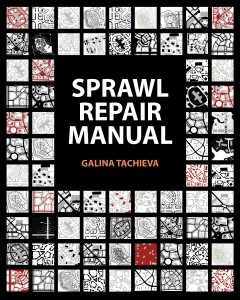The Sprawl Repair Manual presents a comprehensive methodology for transforming sprawl developments into human-scale, sustainable communities. In this richly illustrated book, Galina Tachieva draws on more than two decades of experience to provide a step-by-step process of design, regulatory, and implementation techniques for reurbanizing and rebalancing suburbia.
Her solutions will inspire and equip anyone looking to reimagine suburban development.
The Sprawl Repair Manual is so far the only complete physical planning manual for handling the impending transformation of suburbia into vital human communities. It is not only hugely instructive but formidably inspirational.
—Leon Krier, Master Planner of Prince Charles’ Poundbury Project in Dorset, UK and author of The Architecture of Community
The Sprawl Repair Manual
 Sprawl remains the prevailing growth pattern across the United States, even though experts in planning, economics and environmental issues have long denounced it as wasteful, inefficient, and unsustainable. Sprawl is a principal cause of lost open space and natural habitat as well as increases in air and water pollution, greenhouse gas emissions, infrastructure costs, and even obesity. It also plays a primary role in the housing meltdown plaguing the nation. But is it possible to repair sprawling suburbs and create more livable, robust, and eco-sensitive communities where they do not now exist? This book answers with a resounding “yes” and provides a toolbox of creative approaches for doing just that.
Sprawl remains the prevailing growth pattern across the United States, even though experts in planning, economics and environmental issues have long denounced it as wasteful, inefficient, and unsustainable. Sprawl is a principal cause of lost open space and natural habitat as well as increases in air and water pollution, greenhouse gas emissions, infrastructure costs, and even obesity. It also plays a primary role in the housing meltdown plaguing the nation. But is it possible to repair sprawling suburbs and create more livable, robust, and eco-sensitive communities where they do not now exist? This book answers with a resounding “yes” and provides a toolbox of creative approaches for doing just that.
The Sprawl Repair Manual offers comprehensive guidance for transforming fragmented, isolated and car-dependent development into “complete communities.” Polemical as well as practical, the manual is designed to equip readers – from professional planners, designers, and developers to regulators and concerned citizens – with strategies drawn from two decades of successful repair projects.
In contrast to sprawl – characterized by an abundance of congested highways, strip development, and gated cul-de-sac subdivisions – complete communities are diverse in terms of uses, transportation options, and population. They are walkable, with most daily needs close by.
There is a wealth of research and literature explaining the origins and problems of suburban sprawl, as well as the urgent need to repair it. However, the Sprawl Repair Manual is the first book to provide a step-by-step design, regulatory, and implementation process. From the scale of the region to the building – turning subdivisions into walkable neighborhoods, shopping centers and malls into town centers, and more – today’s sprawl can be saved. Readers who have despaired of ever being able to “take back the suburbs” will find heartening news between the covers of this first-of-its-kind book.
Many of the techniques demonstrated in the book are derived from the work and built projects of DPZ CoDESIGN (DPZ) over the last twenty five years. This effort would not have been possible if the book had not been produced in the DPZ office, supported with the patience and generosity of all partners – especially Elizabeth Plater-Zyberk and Andrés Duany – and aided by the dedicated, talented and savvy contributing team of Judith I. Bell, Maria Elisa Mercer and Rachel D. Merson-Zitofsky and illustrated so gorgeously by Eusebio Azcue and Chris Ritter. Brian Falk at the Center for Applied Transect Studies (CATS), was a thoughtful and challenging advisor on all issues related to writing, content and publishing while Heather Boyer was an enthusiastic supporter and sponsoring editor at Island Press.
Awards
The National Association of Real Estate Editors honored the Sprawl Repair Manual with the 2011 Silver Bruss Book Award, citing “interesting and innovative case studies.” and Planetizen has included Sprawl Repair Manual in the top ten best books in urban planning, design and development published in 2010.